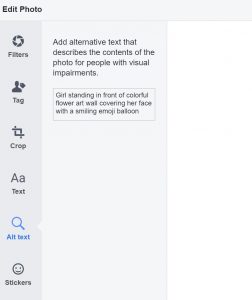Our interaction with the online world is largely textually and visually based. Images are shown to increase engagement between users and their social media sites. If we’re not reading, we’re watching. If not watching, at the very least listening. Then how do we expect users who can’t see or can’t hear to successfully interact with our product?
The short answer is: we can’t.
What we can do is improve our accessibility to allow those users to interact with our product. This is extremely important when considering what markets are being addressed online.
If your ad is an image with words on it, a user with a vision impairment doesn’t receive your message. They might know that there’s an image on their screen but with no descriptor that’s all they know.
Facebook Accessibility
Facebook is currently one of the leading websites continually working to improve the accessibility of their website. Facebook Accessibility is an actual team solely dedicated to improving the experience of any user with accessibility issues.
By catering to its users, Facebook has managed to create an environment where businesses can be sure to reach everyone.
What is Facebook Doing Right?
The Facebook Accessibility Team has prioritized several features in order to improve impaired user experience.
Closed captioning is automatically generated for videos with audio. This is imperative for users with a hearing impairment. Closed captioning can also be read aloud if needed. Some videos also offer a multilingual option when generating captions.
The website’s access and shortcut keys also prove to be an asset for Facebook Accessibility. This allows users to hit a specific key or key combination to perform a certain task. When you can’t see the reply button, or may not have the dexterity to click it, this greatly improves the user experience.
Font size can be customized for users who have problems reading tiny print. This can apply to a wide range of impairments that affect vision or a user that has dyslexia.
The voice over feature improves Facebook Accessibility by having the user’s device read them the present text. Users can also navigate the website itself by using their voice.

What are Facebook Users Doing Right?
While Facebook itself has introduced methods to increase accessibility, it is important for businesses to implement a web accessible practice. . This is the extra step that makes the difference between simply accessible content and accessible content that’s optimal for your business’s potential audience reach.
Facebook already provides automatic closed captioning for videos with audio, but users can edit that audio to make corrections. The generated captioning usually lines up with the video’s actual message, but editing the captioning ensures that it is your exact content that is experienced.
This can be vital when you consider how word choice can affect a user’s response to your Facebook ad. Generated captions aren’t advanced enough to use context clues to self correct, which means sentences like “I’m loving it” can become “Him oven mitt.” For a standard user, its simply a funny mistake, but for users who have specific accessibility needs, you’ve lost the chance to get your message through.
Descriptions of images and videos are also helpful for impaired users. By adding a caption or alternative text, you can strategically clarify the intention behind your posted images. A caption that describes a family happily eating at your restaurant gets the association of happy families. If you add alt text to your image describing a young family with kids, the entire post is now leveraged to support your brand as an enjoyable restaurant well-catered to young families.
Likewise, descriptions of links can be useful. When a link is embedded in text, readers understand the connection between the words that contain the link and the link itself. Adding a link descriptor accomplishes this by giving the user the type of media the link leads to the title of that piece of media. This can help you as a business owner to increase trust and credibility between you and your users.
Hashtags can be difficult to read when they contain full phrases. A way to make your hashtags more accessible is to capitalize the first letter of each word in the hashtag. This increases readability for users with vision problems and helps voice to text programs read out the hashtag accurately.
Combining actual Facebook accessibility features with content designed to reach all users is the key for achieving peak accessibility as a business. For help implementing Facebook accessibility features and strategies contact MAB Accessibility today!
